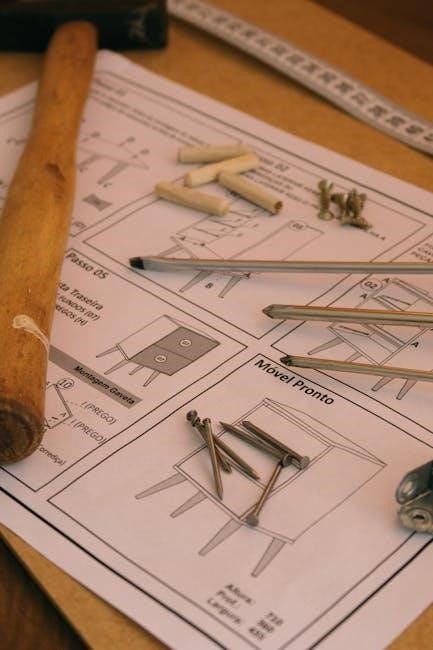Starting a business is an exciting yet challenging journey. It involves developing a concept, planning strategies, securing funding, and turning your vision into a thriving enterprise.
1.1 Why Start a Business?
Starting a business offers numerous benefits, including financial independence, personal fulfillment, and the opportunity to pursue your passions. Many entrepreneurs are driven by the desire to turn their ideas into reality and create value for others. A business can provide a sense of purpose and allow you to impact your community or industry. Additionally, it offers the potential for unlimited earnings, as your success directly depends on your effort and innovation. For some, the flexibility of being their own boss is a major draw, enabling them to set their own schedule and work on projects they care about. Whether you aim to solve a problem, create something new, or build a legacy, starting a business can be a rewarding and transformative experience.
1.2 Understanding the Basics of Entrepreneurship
Entrepreneurship is the process of designing, launching, and running a business, often involving innovation and risk-taking. At its core, it requires a mindset focused on problem-solving and opportunity creation. Entrepreneurs must understand their target market, develop a unique value proposition, and create strategies to outperform competitors. Essential skills include adaptability, resilience, and the ability to manage finances effectively. Networking and building relationships with mentors, investors, and customers are also crucial for success. Additionally, staying informed about industry trends and legal requirements helps entrepreneurs navigate challenges and make informed decisions. By mastering these fundamentals, aspiring business owners can lay a strong foundation for their ventures and increase their chances of long-term success in the competitive business landscape.

Essential Steps to Starting a Business
Starting a business involves defining your concept, researching the market, creating a business plan, securing funding, and launching operations. Each step requires careful planning and execution.
2.1 Define Your Business Concept
Defining your business concept is the cornerstone of entrepreneurship. It involves identifying a problem, creating a solution, and understanding how your business will meet customer needs. Start by refining your idea, ensuring it addresses a specific market gap. Consider what makes your business unique and how it will stand out from competitors. A clear concept helps guide decision-making and ensures everyone involved shares a common vision. Use market research to validate your idea and ensure there’s demand. This step is crucial for crafting a compelling business plan and attracting potential investors. Remember, your concept should be simple, yet powerful, clearly communicating your business’s purpose and value proposition.
2.2 Research Your Market and Competitors
Researching your market and competitors is essential for understanding your business environment. Start by identifying your target audience and their needs. Use primary research, such as surveys or interviews, to gather direct insights. Analyze competitors to understand their strengths, weaknesses, and strategies. This helps you identify gaps in the market and opportunities to differentiate your business. Tools like online surveys, focus groups, and social media can provide valuable data. Additionally, studying industry trends and consumer behavior will help you anticipate challenges and opportunities. A thorough market analysis ensures your business idea is viable and aligns with customer demands. This step is critical for refining your business concept and creating a robust strategy to stand out in a competitive landscape. Accurate market research is the foundation for making informed decisions and driving long-term success.
2.3 Create a Business Plan
Creating a business plan is a cornerstone of starting a business. It outlines your goals, strategies, and financial projections, serving as a roadmap for success. Begin by defining your business objectives and mission statement. Next, describe your products or services in detail, highlighting what makes them unique. Outline your target market and marketing strategies to attract customers. Include financial projections, such as revenue forecasts and expense estimates, to demonstrate viability. A solid business plan also addresses operational logistics and management structure. It should be clear, concise, and realistic, ensuring all aspects of your business are well-thought-out. A strong business plan not only guides your decisions but also helps secure funding and support from investors or lenders. Regularly updating your plan allows you to adapt to changing circumstances and stay on track for achieving your business goals.
2.4 Write an Executive Summary
An executive summary is a concise overview of your business plan, summarizing its key elements. It should be brief, typically no more than one page, and provide a clear snapshot of your business. Start by stating your business name, mission, and vision. Then, outline your business concept, target market, and competitive advantage. Include a summary of your marketing and sales strategies, as well as financial highlights such as revenue projections and funding requirements. The executive summary should also highlight your team’s expertise and the unique value your business brings to the market. It serves as the first impression for investors, lenders, or partners, so it must be compelling and professional. A well-crafted executive summary captures the essence of your business and entices readers to explore your full business plan.

Funding Your Business
Funding your business is crucial for growth. Options include bootstrapping, loans, investors, or crowdfunding. Choose the method that aligns with your business goals and financial situation.
3.1 Bootstrapping: Using Your Own Savings
Bootstrapping involves using personal savings to fund your business, offering control and no debt. It requires careful budgeting and prioritizing essential expenses to sustain operations while growing your venture.
3.2 Securing a Small Business Loan
Securing a small business loan is a popular funding option for startups. Begin by assessing your financial needs and selecting a lender that aligns with your business goals. Prepare a detailed business plan, including financial projections, to demonstrate viability. Gather required documents like credit reports, bank statements, and tax returns. Improve your chances by ensuring a good credit score and considering collateral. Compare loan terms, interest rates, and repayment schedules to choose the best option. Apply through banks, credit unions, or online lenders, and be prepared for a thorough review process. Once approved, use the funds wisely to grow your business while managing repayments to maintain a healthy financial standing.
3.3 Pitching to Investors
Pitching to investors is a crucial step in securing funding for your business. Start by crafting a clear, concise, and compelling pitch that highlights your business idea, market potential, and competitive advantage. Emphasize your unique value proposition and how it addresses customer needs. Provide a detailed overview of your target audience, market size, and growth prospects. Include financial projections, showcasing potential returns on investment. Be prepared to discuss your business model, revenue streams, and scalability. Highlight your team’s expertise and passion, as investors often bet on the people behind the idea. Practice your pitch thoroughly and anticipate questions to build credibility. A strong, confident presentation can make a significant difference in attracting investor interest and securing the funds needed to grow your business.
3.4 Crowdfunding Your Startup
Crowdfunding is an innovative way to raise capital by soliciting small amounts of money from a large number of people, typically through online platforms. It allows startups to validate their product or service while generating initial revenue. Choose a platform like Kickstarter, Indiegogo, or Patreon that aligns with your business goals. Create a compelling campaign with a clear pitch, engaging visuals, and rewards for backers. Share your campaign widely on social media, email, and through your network to maximize reach. Building trust and maintaining communication with backers is key to a successful campaign. Crowdfunding not only provides financial support but also helps build a community around your brand, offering valuable feedback and potentially attracting early adopters. Ensure compliance with platform rules and legal requirements to avoid issues. A well-executed campaign can launch your product effectively and establish a loyal customer base.

Legal Considerations
Understanding legal requirements is crucial for compliance, protecting your business, and avoiding penalties. Consult a legal expert to ensure all aspects of your business operate within the law.
4.1 Choosing the Right Business Structure
Choosing the right business structure is essential for legal protection, tax efficiency, and operational flexibility. Common structures include sole proprietorships, partnerships, LLCs, corporations, non-profits, and cooperatives. Each offers varying levels of liability protection, tax implications, and complexity. Sole proprietorships are simple but offer no liability protection, while LLCs provide a balance of protection and flexibility. Corporations offer strong liability protection but with more formal requirements. Partnerships and cooperatives involve shared ownership. Non-profits focus on social or charitable goals. Consulting a legal expert can help you determine the best structure for your business needs and goals. This decision impacts how you operate, pay taxes, and grow your business. Making an informed choice ensures compliance and supports long-term success.
4.2 Registering Your Business
Registering your business is a critical step to establish its legitimacy and comply with legal requirements. Start by choosing a unique business name and ensuring it’s available by checking state and federal databases. Next, decide on your business structure and file the necessary documents, such as Articles of Organization for an LLC or Articles of Incorporation for a corporation. You’ll also need to obtain an Employer Identification Number (EIN) from the IRS for tax purposes. Additionally, register your business with state and local authorities, securing any required licenses or permits. If you plan to operate under a name different from your legal business name, file for a DBA (Doing Business As). Finally, check if you need to register for sales tax or other local permits. Each step ensures your business operates legally and avoids potential penalties.
4.3 Understanding Taxes and Licenses
Understanding taxes and licenses is essential for maintaining compliance and avoiding legal issues. Businesses must pay federal, state, and local taxes, which vary depending on your business structure and location. Key taxes include income tax, sales tax, and payroll tax if you have employees. Additionally, you may need specific licenses and permits to operate legally. These requirements differ by industry and location, so research what applies to your business. Common licenses include general business licenses, industry-specific permits, and zoning certificates. Familiarize yourself with tax filing deadlines and ensure all necessary permits are obtained before launching. Proper compliance not only avoids penalties but also builds credibility with customers and partners. Stay informed about tax changes and licensing requirements to maintain smooth business operations.

Developing Your Business Plan
Developing a business plan involves defining goals, identifying your target audience, describing products, outlining marketing strategies, and creating financial projections to guide your business toward success.
5.1 Defining Your Business Goals
Defining clear business goals is essential for guiding your startup toward success. Start by identifying short-term and long-term objectives that align with your mission and vision. SMART goals—Specific, Measurable, Achievable, Relevant, and Time-bound—are ideal for clarity. Break down larger goals into smaller, manageable tasks to maintain focus. Your goals should also reflect your target audience’s needs and market demands. Regularly review and adjust them as your business evolves. Having well-defined goals helps in creating a roadmap for your business plan and ensures everyone involved is working toward the same outcomes. This step lays the foundation for strategic planning and decision-making, keeping your business on track for growth and profitability.
5.2 Describing Your Products or Services
Clearly describing your products or services is crucial for attracting customers and differentiating your business. Start by outlining the core features, benefits, and unique selling points. Explain how your offerings solve problems or meet needs in the market. Use simple, jargon-free language to ensure your audience understands your value proposition. Highlight what sets your products or services apart from competitors, such as quality, affordability, or innovation. Include examples or use cases to illustrate real-world applications. This description will not only help in crafting your marketing strategy but also guide potential customers in making informed decisions. A well-written product or service description is essential for building trust and driving sales, ensuring your business stands out in a crowded marketplace.
5.3 Outlining Your Marketing Strategy
A well-defined marketing strategy is vital for reaching your target audience and driving business growth. Start by identifying your unique value proposition and how it addresses customer needs. Choose the most effective marketing channels, such as digital marketing, social media, or email campaigns, based on your audience’s preferences. Develop a content plan that includes blogs, videos, or podcasts to engage potential customers. Consider SEO to improve your online visibility and PPC ads for immediate results. Don’t forget traditional methods like networking or partnerships. Set clear goals, track metrics, and adjust your strategy as needed. A consistent and adaptive marketing approach will help you build brand awareness, generate leads, and convert them into loyal customers, ensuring long-term success.
5.4 Creating Financial Projections
Financial projections are essential for planning and securing funding. Start by estimating revenue, expenses, and profits over a specific period, typically 3-5 years. Break down projections into monthly or quarterly segments for clarity. Include assumptions about market growth, pricing, and customer acquisition. Outline projected income statements, cash flow, and balance sheets. Be realistic and avoid overly optimistic numbers. Consider potential risks and how they might impact finances. Regularly update projections as your business evolves. These forecasts not only help you manage finances but also demonstrate credibility to investors. Use tools like spreadsheets or financial software to streamline the process. A clear financial roadmap ensures you stay on track and make informed decisions.

Marketing and Sales
Marketing and sales are crucial for business success. Identify your target audience, build a strong brand, and develop a sales strategy to attract and retain customers effectively.
6.1 Identifying Your Target Audience
Identifying your target audience is a critical step in marketing and sales. It involves understanding who your ideal customers are, what they need, and how they behave. Start by conducting market research to gather insights about demographics, preferences, and pain points; Use surveys, focus groups, and online tools to collect data. Analyze demographics such as age, gender, location, and income to create detailed customer profiles. Understanding psychographics, like values, interests, and lifestyle, can further refine your audience. This helps tailor your products or services to meet their specific needs. A well-defined target audience ensures your marketing efforts are focused and effective, leading to higher engagement and conversions. By knowing your audience, you can also differentiate yourself from competitors and allocate resources efficiently. This step is essential for building a successful marketing strategy.

6.2 Building Your Brand
Building your brand is essential for creating a strong identity in the market. Start by defining your brand’s mission, vision, and values, which will guide your messaging and customer interactions. Develop a unique and memorable brand name, logo, and tagline that reflect your business’s personality. Consistency is key—use the same visuals and tone across all platforms. Conduct market research to understand your target audience’s preferences and tailor your branding to resonate with them. Establishing a strong brand helps differentiate you from competitors and builds trust with customers. Invest in high-quality visuals and clear messaging to create a professional image. Regularly monitor and adapt your brand to stay relevant in changing markets. A well-crafted brand not only attracts customers but also fosters loyalty and long-term success for your business.
6.3 Developing a Sales Strategy
Developing a sales strategy is crucial for driving revenue and growth. Start by identifying your target audience and understanding their needs and preferences. Conduct market research to gather insights into customer behavior and preferences. Define clear sales goals and objectives, such as monthly revenue targets or customer acquisition numbers. Choose the right sales channels, whether it’s through direct sales, online platforms, or partnerships. Train your sales team to effectively communicate your value proposition and handle objections. Use data and analytics to track performance and refine your approach. Regularly monitor sales metrics like conversion rates and customer lifetime value to optimize your strategy. A well-executed sales strategy aligns your business with customer demands, ensuring consistent growth and long-term success.

Launching Your Business
Launching your business involves setting up operations, hiring a team, and introducing your product or service to the market. Ensure a strong marketing push to attract initial customers and build momentum.
7.1 Setting Up Your Business Operations
Setting up your business operations involves creating a clear plan and organized systems to run your business efficiently. Start by defining your business structure, whether it’s a sole proprietorship, LLC, or partnership. Choose a business name and register it legally. Secure a location, whether physical or virtual, and ensure it meets local regulations. Purchase necessary equipment and supplies, and establish relationships with reliable suppliers. Set up financial systems, including accounting software and payment methods. Hire and train employees if needed, and create a schedule for operations. Develop a customer service plan and ensure all legal requirements, like licenses and permits, are met. Finally, test your systems to ensure everything runs smoothly before the official launch.

7.2 Hiring and Building Your Team
Hiring and building a strong team is crucial for the success of your business. Start by identifying the roles your business needs and create detailed job descriptions. Recruit candidates through job boards, social media, or referrals. Conduct interviews to assess skills, experience, and cultural fit. Once hired, provide comprehensive onboarding to ensure they understand your business goals and values. Foster a positive work environment by promoting collaboration and offering training opportunities. Clearly communicate expectations and provide feedback to help your team grow. Building a loyal and skilled team will help your business thrive and achieve long-term success.

7.3 Launching Your Product or Service
Launching your product or service is a pivotal moment in your business journey. Start by ensuring your market is ready and your offering meets customer needs. Conduct a soft launch or beta test to gather feedback and refine your product. Develop a marketing strategy, including social media campaigns, email promotions, and press releases, to create buzz. On launch day, execute your plan flawlessly, ensuring your website and sales channels are fully operational. Monitor sales and customer reactions closely. Post-launch, analyze performance, address any issues, and adjust your strategy as needed. Celebrate your success and continue to engage with your audience to build loyalty. A successful launch sets the foundation for your business’s growth and reputation in the market.
